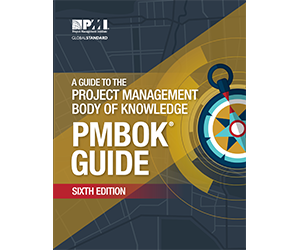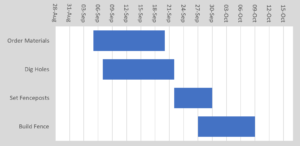
The project plan is like the flight plan filed by a pilot prior to embarking on a journey. It communicates how the project will attempt to reach its destination.
The project plan is the strategy that will be used to produce the project’s products, services, or results. It is written in sufficient detail to communicate to executives and stakeholders how the project will be managed and performed.
To do this, the essential elements of a project plan are:
- Scope statement
- Schedule
- Budget
- Requirements
- Quality criteria
- Project resources
- Stakeholder list
- Communications plan
- Procurement strategy
- Risk management
Scope Statement
Although the schedule and budget are, by definition, at the top of the list of important considerations for most projects, the project scope is actually ahead of them. Because without scope, you don’t have a project. You don’t even make it on to the runway for takeoff.
That’s because scope defines the boundaries of the project. It is a statement of what work is included within the project, and what is not. A good scope statement significantly reduces risk of project overruns and unexpected turbulence.
Schedule
The project schedule communicates to all stakeholders what the expected arrival time will be, and serves to keep the project manager’s hands on the throttle throughout the project.
Since projects are by definition temporary endeavors with a defined beginning and end, the exact location of that end date is a primary consideration for most projects. It’s why, after being awarded a project, the project deadline is usually the first question being asked.
In professional project management, the project is divided into work tasks, called a Work Breakdown Structure (WBS), which is a complicated term for a simple thing. A simple WBS with two tasks looks like this:
| ID | Task Name |
|---|---|
| 100 | Dig holes |
| 200 | Build fence |
To create the project schedule, each task is assigned an expected start and end date, like this:
| ID | Task Name | Start | End |
|---|---|---|---|
| 100 | Dig holes | June 1 | June 10 |
| 200 | Build fence | June 5 | June 30 |
Project schedules are usually communicated in gantt chart form, a horizontal bar chart which identifies the expected start and end dates for each task.
Clearly, the project overall completion date is the end date of the final task.
Budget
If your project loses money, you either have to explain it to the boss or try to get extra money from the owner. Neither is an appealing prospect to most people.
Budgets and schedules are related. Time costs money, and if a project is behind schedule it is likely over budget as well.
However, the budget is a distinct component of the project plan and should be treated as such. To include the budget in the project plan, another column is added to the table, called “budget”:
| ID | Task Name | Start | End | Budget |
|---|---|---|---|---|
| 100 | Dig holes | June 1 | June 10 | $1,000 |
| 200 | Build fence | June 5 | June 30 | $9,000 |
Seems like you’re most of the way there already, and actually, you are. But there are still many, smaller pieces that will make the project plan sing if you let them.
Requirements
If you’ve ever been on an airplane with uncomfortable seats, crying babies in the seat beside you, or cranky flight attendants you know that there is more to a successful flight than simply arriving at the destination.
All projects have requirements. For example, if you’re building a fence, somebody’s expecting it to be a certain size, color, or type. In project manager-speak, we say that stakeholders have expectations. Even if these requirements are not written down anywhere, you need to know what they are, and the project plan is the perfect place to quantify them.
Quality criteria
 Most projects need to meet a certain quality criteria. Often there are even quality control inspections, final project inspections, and other processes to ensure the quality criteria is met. Nobody wants to fly on an aircraft that hasn’t been thoroughly inspected, hence quality measurements are taken to ensure conformance, and the project team is wise to plan this into their project work.
Most projects need to meet a certain quality criteria. Often there are even quality control inspections, final project inspections, and other processes to ensure the quality criteria is met. Nobody wants to fly on an aircraft that hasn’t been thoroughly inspected, hence quality measurements are taken to ensure conformance, and the project team is wise to plan this into their project work.
The quality criteria should be identified in the project plan, including pass/fail requirements, as well as the methods used to ensure the quality criteria will be met.
Project Resources
If you don’t want to make an emergency landing, you need to make sure the fuel tanks are full while the plane is still on the ground.
Resources often require the most planning and coordination throughout the project’s execution. That’s because they arrive late, require unexpected maintenance, don’t meet specifications, or any other host of issues that can trip up a project. Resources are:
- Manpower
- Tools and Equipment
- Materials
- Facilities
To properly account for resources in a project plan, each task is assigned the resources it needs to carry out its work. The resources are pinned to the task. We will return to our original example:
| ID | Task Name | Start | End | Budget | Resources |
|---|---|---|---|---|---|
| 100 | Dig holes | June 1 | June 10 | $1,000 | Bob, Shovel |
| 200 | Build fence | June 5 | June 30 | $9,000 | Bob, John, Fenceposts, Fence material, Nail gun, Nails |
After this, the each resource is inspected and its availability is secured. Obviously, you need Bob from June 1 – June 30, John from June 5 – June 30, and the fence material needs to arrive before June 5.
Since the resources have budget implications (you have to buy the fence material), this step should in fact be nailed down prior to finalizing the project budget. I have included it after the budget for clarity and to allow for small projects where budget determinations are easy.
Stakeholder List
 A stakeholder is anyone that has an interest in the project. Every project has a minimum of one stakeholder called a project sponsor, who is the person who initiated the project and receives its deliverables. They are one level above the project manager (i.e. outside the project).
A stakeholder is anyone that has an interest in the project. Every project has a minimum of one stakeholder called a project sponsor, who is the person who initiated the project and receives its deliverables. They are one level above the project manager (i.e. outside the project).
The project team who carries out the work is a stakeholder. They wish to be treated well and compensated fairly for their work. They usually want to finish the project with something more than they started, like more experience or a better chance at the next project.
Other, external stakeholders can often trip up a project. Environmental groups, adjacent landowners, utility companies, government regulatory agencies, and the like, often fly under the radar until they suddenly demand expensive project changes.
The project plan should list all of the stakeholders and analyze:
- Their interest in the project
- Their ability to cause project changes
Communications Plan
 Naturally, the stakeholders need to know certain project information at certain times. Hence, the project plan should itemize what, when, and how each stakeholder will receive their communication.
Naturally, the stakeholders need to know certain project information at certain times. Hence, the project plan should itemize what, when, and how each stakeholder will receive their communication.
- Management needs to know the project schedule and budget status
- The project team needs to know certain technical information
- External stakeholders need to know how their concerns are being addressed
- The end user needs to know how the project will improve their lives
- The project sponsor needs to know about project issues and how they are being resolved
Procurement Strategy
Procurement means purchasing of outside goods, materials, and services. In small companies, you can usually go out and buy things without too much hassle. In larger companies, you might have to get multiple layers of approval or develop a contract. Maybe there is even a procurement department that does the purchasing.
Because of the many legal and contractual issues with purchasing things, the project plan should contain a listing of the items that need to be purchased as well as a strategy for performing the procurement activities.
Risk Management
 All projects have risk. As a minimum, the project has a risk that it does not achieve its intended business goals. Of course, the project itself contains many execution risks that result in the business case not being fully realized.
All projects have risk. As a minimum, the project has a risk that it does not achieve its intended business goals. Of course, the project itself contains many execution risks that result in the business case not being fully realized.
Risk mitigation involves 4 steps:
- Risk Identification
All risk events that might impact the project’s success are brainstormed and defined. - Risk Analysis
The risks are analyzed according to their two underlying components:- Probability. If an event is likely to occur, it is considered high risk.
- Severity. If an event causes large damages, it is considered high risk.
- Prioritization
An overall prioritization ranking of the most important risk events is carried into the project plan for ongoing tracking. Any risks deemed not important enough are not included. - Risk response plans
Response plans are developed for the most important risks so that rapid action can be taken when (if) they occur.
Large megaprojects, like the olympics or industrial projects, spend a significant portion of their project budget developing (and rehearsing) rapid response plans for a long list of possible risk event scenarios. If megaprojects do it, then the process would have value for small projects as well (although correspondingly smaller).
Project Management Methodologies
 Developing project plans is one of the most foundational components of the Project Management Body of Knowledge (PMBOK Guide), developed by the Project Management Institute (PMI). Project planning is one out of five “process groups” and the development of a project management plan is well documented. Competence of the PMBOK is demonstrated by obtaining the Project Management Professional (PMP) or Certified Associate in Project Management (CAPM) designations.
Developing project plans is one of the most foundational components of the Project Management Body of Knowledge (PMBOK Guide), developed by the Project Management Institute (PMI). Project planning is one out of five “process groups” and the development of a project management plan is well documented. Competence of the PMBOK is demonstrated by obtaining the Project Management Professional (PMP) or Certified Associate in Project Management (CAPM) designations.
Although the PMI maintains the most widely used project management methodology and certification scheme in the world, the PRINCE2 methodology is a fast growing certification scheme for project managers which is easier to obtain, but represents a specific project management method. It includes details of roles and responsibilities which must be fulfilled to quality as a PRINCE2 project, rather than a general project management expertise bank. Thirdly, the International Project Management Association (IPMA) maintains a certification scheme called Individual Competence Baseline (ICB) that focuses on project manager “competence elements” (like leadership, negotiation, teamwork, etc.). The ICB works well for certification, but is not structured as a guide for project management activities.






